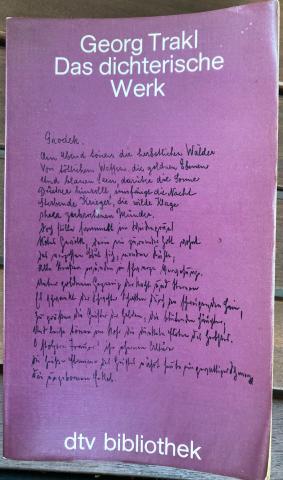
(Note on a poem--filed under book reviews.)
Depressive, drug and alcohol addicted, in love with his younger sister, the major lyric poet George Trakl died of a cocaine overdose at 27 after seeing a battle in WWI. Born 1887, he was a later generation than Baudelaire, and the comparison will probably irritate specialists. I mention it because many English-speaking readers will not have heard of him, and a certain similarity with Baudelaire may help them get their bearings.
In his early poems he imitated Baudelaire. He builds up sets of images, sounds, thoughts, impressions, as does Baudelaire, a technique sometimes called Symbolism. However, in his later poems Trakl tends to drop the rhyme and metre which typify his imitations of Baudelaire. Some of the pieces are not written out in lines at all, so will be called "prose poems". Where there is division of a poem into lines, the division often seems to be more between images, than on the basis of euphony. Throughout his work he has favourite themes--notably death, autumn, night, and generally anything sad. And he has favourite words: the German words for "stony", "night-like", "still", and "silent" ("leise"). Work of this kind is imbued with depressiveness, and can induce depression in the reader. The loveliness of some of the poems may be best enjoyed in small doses.
The poem "In Venice" is in the poetry cycle Sebastian in Dream. Why Sebastian? Trakl was born in Salzburg, close to St Sebastians church, as it happens the local church of Mozart's family. St Sebastian was tied to a post and had arrows shot into him. The image of Sebastian, trapped (as one might think Trakl was by addictions), with arrows sticking out of him, both inside the church and over the door, must have appealed to the young man who suffered mental torment.
Sebastian im Traum is split into subsections (five in the first published edition, which appeared posthumously in 1915). In Venice is the first poem in a section "Song of the Departed". The German title of the section, and of the last poem in the section, is Gesgang des Abgeschiedenen. This is suggestive of "Abschiedsbrief", German for "suicide note". Whether the overdose which Trakl, a qualified pharmacist, took, was deliberate is not known, thought it is known that he was suicidal.
In August 1913 Trakl holidayed in Venice with some big names of Viennese modernism, to whom his patron Ludwig von Ficker had introduced him. There was the anti-ornament architect Adolf Loos, journalist Karl Kraus, and café barfly and writer Peter Altenberg. They seem to have stayed on the Lido.* Soon after the holiday, Altenberg, a skirt-chaser, published a piece entitled Le Lido in French suggesting he could not enjoy the seaside because he could not take his eyes off a woman:
As-tu vu le sable brun de la mer?!
Non, je n'ai rien vu - - -
As-tu vu l'eau sans fins et les écumes blanches?!
Non, je n'ai rien vu - - - j'ai vu Maria!
As-tu entendu le bruit de la mer?!
Non, je n'ai rien rein entendu - - -
j'ai entendu la voix de Maria!
n'as-tu pas senti venir la santé du corps, par le soleil?!
Non, j'ai senti venir la maladie de l'âme, par Maria!
**
Erfülle Bitte um ein Autogramm, an Herrn Platon de Naxel, Venise:
"Il y a un mystère, qui nous fait vivre - - la femme!
Il y a une réalité, qui nous fait mourir - - la femme!"
(Text taken from Karl Kraus' own selection of Altenberg's writings, Wien 1932, reprinted Zürich 1963, p294. The text is available online at Project Gutenberg.)
Does the use of French indicate that Maria was not a German speaker? This is the world of Death in Venice, the smart hotels on the beach, backdrop for a holiday infatuation which is too painful to bear.
There is actually a photo of Trakl on the beach at Lido (and a photo of Altenberg and Kraus), though his poem makes it clear he was not enjoying the holiday any more than the besotted Altenberg of the above literary postcard was. Trakl's own pain was intense enough already, without the need to involve a new amour, and there is evidence that his love for his own sister made him feel guilty. Whether she is the "child" in the Venice poem cannot be known for sure. It is likely that he was thinking of the Lido, where he was staying: we can think of him lying sleepless in his room in Grand Hotel des Bains (the hotel also frequented by numerous luminaries, Thomas Mann, Arthur Schnitzler, Stravnisky and so on), while the candles flickered in the room and the sea lay deathly silent outside his window.

There are multiple translations of the poem to be found online, and the German text is easy to find. Here is my translation:
Quietly in the night-filled room,
Like silver the candlelight
Flickers to the breath
Of the lonesome one.
A blackish swarm of flies
Darkens the stony space,
And there stares from the anguish
Of the golden day the head
Of the homeless one.
Unstirring is the sea in the night.
Star, and the nightly journey
Slips away on the canal.
Child, your sickly smile
Follows me silently in sleep.
(The original text is reproduced here.)
*There is a letter in the Innsbrucker Ausgabe of Trackl's works, vol. V. p.483, where Trakl says he is feeling inexplicable anxiety about going to Venice. The notes say he seems to have travelled there on 16 August 1913, and that he and the von Fickers stayed in the town, while the Viennese group stayed on the Lido. They don't give a source, and I could not find one in the the letters of Trakl or von Ficker. The photo shows he visited Lido, and I am repeating the claim he stayed at Hotel des Bains on Lido, but it is only a guess.